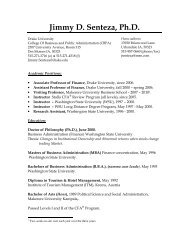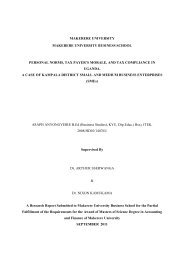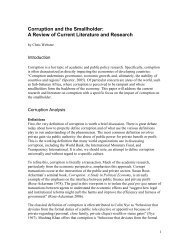13th Annual International Management Conference Proceeding
13th Annual International Management Conference Proceeding
13th Annual International Management Conference Proceeding
Create successful ePaper yourself
Turn your PDF publications into a flip-book with our unique Google optimized e-Paper software.
experience empathy is a social entrepreneur. This implies that empathy is necessary but not sufficient<br />
condition in the SE process. A certain level of empathy is needed in order to trigger perceived social venture<br />
desirability, which in turn will lead to intentions to create a social venture.<br />
Moral judgment represents an additional concept that is frequently employed to explain helping responses<br />
(Comunian &Gielen, 1995). Under the assumption that moral norms regulate the actions of individuals,<br />
Lopez, Apodaka et al.(1994) define moral judgment as the reasoning an individual follows to justify his/her<br />
actions in the face of moral dilemma. For the purpose of this research moral judgment was defined as the<br />
cognitive process that motivates an individual to help others in search of a common good.<br />
Kohlberg and Hersh (1977) claim that, moral judgment develops in human cognition through a sequential<br />
series of six stages, which increasingly demonstrate a higher capacity for empathy and justice. The most basic<br />
form of moral judgment is when individuals consider the goodness or badness of actions depending on their<br />
physical consequences regardless of their human meaning or value (punishment-and-obedience orientation).<br />
As an individual educates his/her moral judgment, he/she passes through more sophisticated stages of moral<br />
reasoning until reaching the sixth stage (the universal-ethical-principle orientation), the most developed form<br />
of moral judgment.<br />
Individuals moral judgment is affected by exposure to social experiences that make an individual deal with<br />
the needs, values, and viewpoints of others (Comunian &Gielen.1995); perceived magnitude of the<br />
consequences (i.e. the perceived harm or good done to an individual) and the social consensus (the level of<br />
agreement on the goodness or evil of a proposed act) (Morris & McDonald, 1995).<br />
Prabhu (1999) found that social entrepreneurs are motivated by a need to be loyal to their own principles,<br />
and to socially responsible. Johnson (2000) claims that; social entrepreneurs crave for social justice and I<br />
propose that this can only be achieved if social capital is prevalent in the community social entrepreneurs<br />
intend to establish a social enterprise.<br />
2.2 Relationship between cognitive & emotional characteristics and social capital<br />
In organizations like the Grameen Bank, we may well find examples of what Sfeir-Younis (2002) calls<br />
“spiritual entrepreneurship”: a paradigmatic shift away from traditional entrepreneurship expressed in the<br />
form of a personal challenge: “How can I encourage everyone associated with this enterprise to work from<br />
the highest possible level of awareness?” (p. 44). Such a vision entails profound commitments to ethics in the<br />
treatment of others (including competitors), the linkage of the organization to the idea of a self-realization,<br />
and constant reflection on the contribution of the organization to society. Although coming out of a United<br />
Nations agency context, Sfeir-Younis argues for the application of this term and model to the private sector<br />
as well. All commentators on social entrepreneurs agree that exceptional personal characteristics, usually held<br />
by a single person though sometimes manifested by a group, are not only helpful but essential to success.<br />
Waddock and Post (1991) argue that significant personal credibility is a key to the social entrepreneur's<br />
work and to her ability to enlist the commitments of others. Like the term “strategic philanthropy”, “social<br />
entrepreneurship” is an articulation (Hall, 1986; Slack, 1996), a combination of two concepts that do not<br />
naturally fit together and yet which seeks acceptance as common sense. It is the lack of a natural fit that<br />
renders the term open to resistance and challenge. Challenges, implicit or explicit, range from different<br />
interpretations of how the terms might justifiably be joined to denial that they should be used together at all.<br />
If the colonization of the social and public sectors by the language of business is accepted, the breakdown of<br />
barriers between the sectors becomes normalized. However, the terms cited are in contrast to the distinction<br />
made by Thompson (2002) between entrepreneurs who create social or artistic capital rather than financial<br />
capital, with social capital referring to that which is valuable to communities (p. 413). The concept of social<br />
capital, without a financial element, also emerges in descriptions of social entrepreneurs, with examples that<br />
include the Crimean War nurse, Florence Nightingale (Bornstein 2004).<br />
An extract from a speech by UK Prime Minister Tony Blair in January 1999) emphasizes the role of social<br />
capital in fostering social entrepreneurship.<br />
62
















